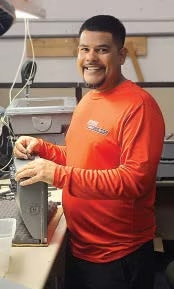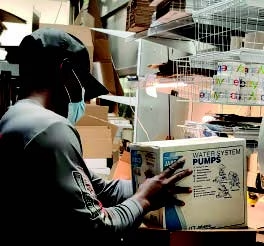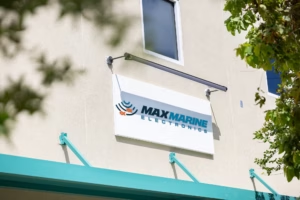Anyone who has walked the aisles of boat shows in recent years knows how innovative new electronics can draw a big crowd. Talk to manufacturers and you’ll hear that useful new functions and features drive sales. And yet one company is thriving, expanding and building a much larger facility, all financed from the sales of older, often used marine electronics.

Julian “Max” Stein launched Max Marine Electronics (MME) in 2011, inspired by sales of equipment like an Apelco fishfinder that he bought cheap at a garage sale and sold on eBay for “an insane amount of money.” Stein asked the buyer, a dealer, why he’d pay $250 for a used fishfinder when he could buy a new replacement brand for half the cost. Simple, said the dealer, his customer didn’t want the hassle of recutting the dash or installing a new transducer along with paying for some additional electrical work. “That’s when a lightbulb went off in my head,” says the 37-year-old company founder and CEO. He abandoned his pursuit of a business degree at college, rented space in south Florida, and incorporated his new company, which focused on buying and selling older electronics.



Today, a decade later, MME describes itself as the “world’s largest supplier of legacy marine electronics.” It has a staff of over 20 full-time employees, some dealing with the core function of equipment sales, others refurbishing electronics purchased from various sources and a five-person team tasked with logistics such as warehouse organization, shipments, insurance issues that may arise and so forth. Most equipment shipments are to buyers in the US, but some go to Europe, Asia, and the Middle East. Stein mentions an internet buyer in the United Arab Emirates that ordered a bunch of refurbished Garmin Echomap units—10 at a time—and another in Morocco that purchases vintage Simrad Fisheries units regularly.
“My business is all about relationships. It has grown organically and not because of any master plan,” says Stein. “We started by finding products on Craigslist and forums like The Hull Truth. Once the marine electronics world found out this guy was buying old equipment they started seeking me out and not the other way around. Business evolved naturally and on the fly.”
MME has escaped serious damage from the pandemic, and in fact has benefitted from Covid-caused supply shortages. When some buyers of new electronics found they could not take delivery for six months or so, they turned to legacy equipment that was on the shelf at MME and ready to ship.
Where the electronics come from
Most of the equipment MME buys comes from refits performed by dealers and installers. Among the most common electronics MME takes in and sells are MFDs, radars and sounder modules. The dealers that sell to MME often apply the trade-in value to offset and lower install costs to their customers. Some equipment is sourced from dealerships that are shutting down. They also regularly purchase obsolete
equipment from manufacturers, distributors and individuals, sometimes entire lots. Stein says the major manufacturers often sell older or factory-refurbished equipment directly to distributors, and that MME makes a point of not getting between manufacturers and distributors in that relationship. If they wind up with more old inventory than they want, distributors and smaller OEMs will contact us.
Among the legacy electronics that arrive are new old stock items, some still in boxes. Overall, the ‘sweet spot’ age for legacy electronics they sell is 10-20 years-the oldest they get in with any regularity is from the 1980s. Brands like Datamarine, Cetrek, and Interphase still come in often. Stein remembers a time a retiring dealer sold them a bunch of Wesmar searchlight sonars from that era. “We fired up the CRT and smoke came out. We listed it to our store [as a parts-only product]-and someone bought it,” says Stein.
For electronics that need repairs, MME spends a lot of time sourcing parts that typically go bad. Aside from the normal components that can be purchased from the large semiconductor supply houses, MME sources LCD screens for several units from suppliers around the world.


As for bench-top servicing that the MME team continues to do in-house, Stein says they do some component-level repairs but not a lot of it. “Most of the electronics we get are working but need something minor. The number one thing that takes marine electronics out is moisture intrusion. Most pathways for water intrusion can be mitigated with processes we have developed over the years. When we get a unit in, we look for weak points we know are common-fix them and proof them from future damage.”
Sometimes equipment needs more than a little attention. “The seller says it worked ok when he removed it from the boat,” says Technical Sales Director Zack Vogel, who joined us for the interview. “You open it up and half a cup of water pours out. Or the screen has gone bad.”
One problem they often see is worn VHF mic cables due to deterioration of the material after a decade or more. MME reproduces the cables using a combination of 3D printing, soldering, and assembly. This 3D printing has spawned a new department at MME, which produces everything from the alignment coins for mounting brackets to the Robnet2 bushings found on Simrad autopilots. All prototyping, design, and production work is done in-house.
Another specialty is transducers-MME receives Airmar, Radarsonics, and even Hondex units that are decades old and often without any identification. MME tests them and calculates frequency and impedance in order to specify the correct element.
Equipment that’s beyond repair or not fit for sale is dismantled for parts that are used to service other devices in house. MME steers away from selling parts on the internet to avoid what the CEO calls “going down the used parts rabbit hole.” He explains that a buyer will call and request a printed circuit board, but when it arrives and it turns out the PCB is not the problem, the buyer returns it and asks for another part. MME has to test the returned part, put it back on the shelf and ship the next component. “We can go back-and-forth trying different parts when we could have sold them a complete unit that saves them and us hours of labor.”
A concern Stein had years ago when electronics moved away from dedicated units toward networked MFDs and modules was the impact it would have on the demand for separate devices. Fortunately for MME the demand for legacy equipment continues strong-and, in fact, is growing. That’s what is fueling construction of the company’s new 14,000-square-foot office and warehouse building.
Who are the buyers?
Buyers break down equally into two main camps-end users and installers- with recreational boaters far exceeding commercial buyers. Most of the installers tend to be employed by smaller dealerships, although some equipment goes to larger shops that may be trying to help a customer out of a jam. Either way, MME tests all equipment before they ship it and provides a 90-day warranty.
Practicality is the principal motive for purchases, says Stein. Commercial buyers- Gulf shrimpers for instance-want to replace malfunctioning equipment with the same gizmo they know and like. “There are guys who want an original Furuno Navnet system. They have no desire to explore anything newer.”
Among the recreational buyers are customers who like their old Northstar GPS’s or other legendary brands and are determined to stay loyal. Stein describes a customer who has two Northstar 6000i units and a complete radar in his closet that are ready to go if the matching equipment on his boat goes bad.
Another customer had a 1995 vintage Raymarine X-series radar with a malfunctioning CRT display. MME didn’t have a Raymarine replacement but had an






